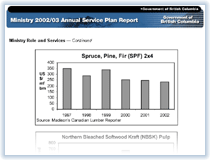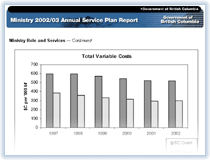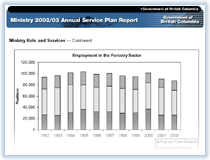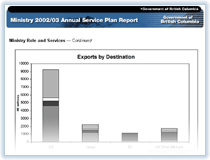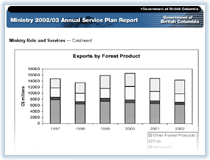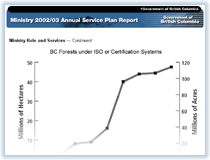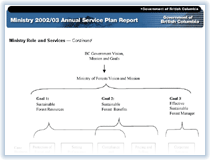 |
|
Ministry Role and ServicesIntroductionThe Forest Service is the main agency responsible for the stewardship of 47 million hectares of provincial forestland. In addition, the ministry provides fire protection services for 84 million hectares. Managing these provincial forests presents a unique and complex set of challenges. More than 90% of British Columbia's forestlands are publicly owned, which means that the provincial government, on behalf of the public, plays a much more prominent role in the forest sector than its counterparts in other forestry jurisdictions. The ministry pursues its goals for sustainable forest resources and benefits in a consultative manner with the public, industry, and other Crown agencies, while recognizing the unique interests of aboriginal people. In this way, the ministry works to earn the public's trust as our staff make the day-to-day decisions which ensure that all British Columbians can look forward to healthy forests and a strong forest economy now and in the future. The key legislation, for which the Ministry of Forests is responsible, is summarized in Appendix 1. Ministry StructureAs a result of the Core Services Review and government direction on reductions to ministry resources, in 2002/03 the ministry reduced from 6 regional offices and 40 district offices to 3 regional offices, 29 forest district offices and 4 satellite offices. It created 12 new BC Timber Sales offices at district locations and continued the existing 6 fire centres. This reorganization will maintain the field presence required for the ministry to carry out its stewardship mandate. A current Organization Chart is provided in Appendix 2. Ministry Vision, Mission and ValuesVisionHealthy Productive Forests Since its establishment in 1912 as the Forests Branch, the BC Ministry of Forests (also known as the Forest Service) has continued to protect the public's interest and provide leadership in the protection, management and use of the province's forest and rangelands. Its 2002/03 vision of "Healthy Productive Forests" reflects the ministry's mandate to ensure that the health and productivity of the province's forest and range resources are maintained now and in the future. MissionProtect and manage our public forests for the sustained benefit of all British Columbians As stewards of British Columbia's forest and range lands, the Forest Service undertakes the key responsibilities of: protecting and managing the province's forest and range resources; providing the basis for a globally competitive forest industry with high environmental standards; and, maximizing net revenues to the Crown. These responsibilities were reflected in the 2002/03 mission statement to "Protect and manage our public forests for the sustained benefit of all British Columbians". ValuesThe Forest Service protects the public's interest in its forest and range lands through a commitment to the values of respect, service excellence, accountability, openness and adaptiveness, and a can-do attitude. We are guided by the ethics of sustainable use, stewardship and public service. Strategic Shifts and Alignment with the Government Strategic PlanThe Core Services Review of the ministry, completed in the fall of 2001, directed the ministry to move to results-based regulation, establish defined forest area management, and pursue alternative arrangements for direct delivery with the forest industry and other stakeholders. This direction resulted in significant changes to the ministry's vision, mission and goals as reflected in its Service Plan 2002/03 – 2004/05. The ministry also implemented key strategies during 2002/03 to meet this direction. These strategic shifts within the ministry align directly with the long-term goal of a sustainable environment and associated key strategies and actions as outlined in the Government Strategic Plan 2002/03 – 2004/05 and the government's New Era commitments for sustainable forestry. The ministry operates under a legislative framework comprised of the Ministry of Forests Act, the Forest Act, the Range Act and the Forest Practices Code of British Columbia Act. To implement the major forest policy changes associated with the ministry's strategic shifts, significant amendments to the ministry's legislative framework were implemented in 2002/03. Update on New Era CommitmentsIn 2001, the provincial government established 11 commitments for their New Era of Sustainable Forestry, which fall within the ministry's mandate. The table below summarizes the ministry actions to date in achieving these commitments. Further information on the ministry actions during 2002/03 is found in the "Performance Reports" section.
Updated Environmental ScanIntroductionFor both the Ministry of Forests and the forest sector generally, 2002/03 proved to be a challenging year with revitalization, policy change and forest health dominant themes. Internal Challenges Forest health was a major concern during 2002/03. The unprecedented epidemic of mountain pine beetle is causing significant damage to the Interior forest resource. In 2002, the beetle infestation expanded to include an area of about 9 million hectares, stretching from Smithers to Cranbrook. The beetle epidemic is essentially impossible to control by man-made means. Implementation of new government forest policy direction to meet the core service review objectives was a major focus for the Ministry in 2002/03. In December 2002, streamlining amendments to the Forest Practices Code of British Columbia Act and regulations came into effect. These amendments will reduce the number of transactions between government and licensees over a two-year transition period until the new Forest and Range Practices Act is fully implemented in December 2005. By streamlining the existing code now, resource management practitioners will work toward a results-based forest and range practices regime. Government's commitment to the introduction of a new market-based pricing system, putting the Small Business Forest Enterprise Program on a more commercial footing, and deregulation, resulted in the announcement of the Forest Revitalization Plan in March 2003. The plan consists of a comprehensive set of legislative and policy reforms that will create opportunities and build a more diverse forest sector, remove barriers to regional job creation and open up new partnerships with First Nations. Implementation of the Forest Revitalization Plan requires some reallocation of existing harvesting rights. To that end, on March 31, 2003, government initiated reallocation of 20 per cent, or 8.3 million m3, of harvesting rights from major licensees. One-time funding of $200 million has been set aside by government for compensation purposes. Transition assistance, in the form of a $75-million trust fund, will also be available. About half of the reallocation volume will be used to open up opportunities for First Nations, woodlots, and community forests. The other half will be used to increase the amount of timber sold through competitive auction. The auction results will form the foundation of the new market based pricing system. Implementation of both the reallocation and market based pricing will be a focus for the forthcoming fiscal year. Another feature of the forest revitalization plan is the creation of the BC Timber Sales organization. This organization has replaced the former Small Business Forest Enterprise Program. The new organization is commercially focused. Its core purpose is to market Crown timber to establish market prices and capture the value of the asset for the public. Other policy changes aimed at revitalizing the forest sector include changes to cut control regulations, the elimination of timber processing and appurtenancy requirements, and the elimination of mill closure penalties. In addition, the regulatory burden associated with tenure transfers and subdivisions has been reduced. The changes remove requirements that have caused forest companies to maintain uneconomic operations and harvest public timber at a loss. Once the changes are in place, wood will be better able to flow to its highest and best use. Despite forest health problems and despite the broad array of policy changes and the significant workload they imply, the Ministry of Forests proceeded with Core Service Review restructuring during 2002/03. Ministry funding will shrink 35 per cent from 2001/02 to 2004/05. During 2002/03, as a first step towards the Core Service Review results, Ministry staffing levels declined by 14.8 per cent and the Ministry's operating expenses were reduced by 15.5 per cent. External Challenges As expected, the softwood lumber dispute and U.S. market access continued to be a major issue over the course of the 2002/03 year. Some highlights included the following:
The world economic situation also continued to be a challenge in 2002/03. The International Monetary Fund estimates the global economy grew at a rate of 3% during 2002.1 However, Japanese economic growth remains slow and competition from the European and Russian forest sectors is increasing. The strengthening Canadian dollar will also be a challenge for forest product exports in the forthcoming year.
Prices, Costs and PerformanceBC's forest industry is dominated by the production of lumber, pulp and paper. These commodities are then sold into the global market place. Despite the softwood lumber tariff, BC harvest levels, as measured by timber scale billed, increased by a modest 2% in 2002, rising from a provincial total of 72.0 million cubic metres (m3) in 2001 to 73.4 million m3 in 2002. Increased harvest levels were likely due to higher Canadian and US housing starts.
Reliance on exports of forest products means that global prices are strong indicators of market demand and important determinants of the health of the sector. In 2002/03 prices for forest products were generally weak with lumber, pulp and paper all posting declines.
In 2002, total variable costs, or costs that vary directly with output, remained relatively steady compared with 2001. Costs rose slightly on the Coast and declined slightly in the Interior. For the Coast, increasingly difficult terrain, environmental pressures and changing markets will likely continue to create cost challenges.
Overall, total sector employment declined by 4.0 per cent or more than 3,000 positions, primarily in solid wood products employment.
In 2002, forest product exports accounted for 48.0 per cent of total provincial exports and had an estimated value of $14.4 billion. The primary market for BC forest products is the United States. The U.S. accounted for over $9 billion of forest sector exports while Japan, the second largest market, imported products worth more than $2 billion. Exports to European countries totalled slightly more than $1 billion.
Overall, provincial forest product exports were down in 2002 falling from $14.5 billion in 2001 to $14.4 billion in 2002. The decline in lumber exports was tempered to some extent by an increase in other forest product exports.
Supply and Sustainability Four supply-related issues will continue to affect the long-term prospects for the provincial forest sector. These issues are:
World Timber Supply The Food and Agriculture Organization's "State of the World's Forests 2003" report predicts that land conversion and silviculture practices will, in the long run, be key determinants of the level of timber supply. However, the report also notes that enhanced tree growth, mainly as a consequence of increased global temperatures and longer growing seasons have been observed in many regions of the world. For example, the annual increment of Norway spruce in Austria increased by about 17 per cent, during the period 1961 to 1995. Certification An increasing number of provincial forest companies are becoming certified. In 2002/03 ten additional B.C. companies were certified increasing by more than 8 million hectares the total area of certified forests.
Source: BC Ministry of Forests, Jan. 2003
First Nations Land Claims Clarity around First Nations land claims will improve both the long-term stability of the provincial timber supply and the investment attractiveness of provincial forest enterprises. In the meantime, the Ministry is taking action to increase First Nation participation in the forest sector and accommodate First Nation interests. In May 2002, the government introduced legislation enabling the Minister of Forests to directly award forest tenures to First Nations in order to create participation opportunities. Since then seven agreements have been signed, providing First Nations with rights to 1.1 million m3 of timber over a number of years. As part of the forestry revitalization plan, more volume will be made available to First Nations. Over time, the allowable annual cut available to First Nations is targeted to rise to 8 per cent of the core allowable annual cut. Forest Stewardship and Forest Health The introduction and implementation of the results-based code of the Forest and Range Practices Act is aimed at improving provincial forest stewardship. Through its results-based approach the new code focuses on the end result of responsible forest management rather than the means by which it is achieved. By being more adaptable, the new code rewards innovation and will be backed by tougher enforcement, including higher fines and regular monitoring. The ongoing improvement of forest stewardship is also the objective of the legislation introduced in 2002/03 to establish the College of Applied Biology, the first of its kind in Canada. The act is designed to improve forest management by registering biologists and holding them accountable for their work. Under the Forest and Range Practices Act and the redefined Forester's Act, resource management professionals will have increased responsibility for protecting the environment. The work of the Forest Investment Account (FIA) began in 2002/03. FIA was created to promote sustainable forest management in British Columbia. It is founded upon a Vote of the Legislature, authorizing the Minister of Forests to provide funding for certain forest management activities. FIA expenditures totalled $144 million in 2002/03 including $38.5 million of Forestry Innovation Investment expenditures. In the area of forest health, the Mountain Pine Beetle infestation will continue to be a pressing problem for the province for the foreseeable future. In 2002/03 the Chief Forester increased the allowable annual cut by 2.9 million cubic metres to address the mountain pine beetle problem. Estimates of the beetle's rate of spread indicate that every infested tree removed at the front of the infestation will save up to 16 trees from being attacked the following year. Conclusion As ever, the B.C. forest sector and the Ministry of Forests will continue to face challenges in 2003/04. Implementation of the broad array of legislative changes introduced in 2002/03, resolution of the softwood lumber dispute, and dealing with the mountain pine beetle epidemic are only a few of the issues that will have to be dealt with. Ultimately, to be successful in the ever-changing global economy, the forest sector will have to be outwardly focused, competitive and environmentally responsible while the Ministry will have to ensure that appropriate legislation, policy and business processes are in place to support these outcomes.
Linkage of Ministry Goals to Performance ReportingThe Forest Service established three long-term goals in 2002/03 to provide overall strategic direction to the ministry in achievement of its mission and vision: 1. Sustainable Forest Resources — the use of the forests to generate economic benefits is balanced with the long-term health of the forest and range resources. 2. Sustainable Forest Benefits — the citizens of British Columbia benefit from commercial use of their forests. 3. Effective Sustainable Forest Manager — the Forest Service is comprised of highly trained and knowledgeable staff focused on ensuring that sustainable forest resources deliver sustainable forest benefits for the people of British Columbia. The framework below has been developed to assist the ministry in achieving these three goals. Five core businesses were established (called core functions in the 2002/03 – 2004/05 Service Plan) which incorporate all the activities carried out by the Forest Service. Each of the core businesses is linked to at least one of the three goals; the Compliance and Enforcement core business supports two of the three goals. Under each core business are structured the associated objectives and strategies of the ministry. To indicate how successful the ministry is in achieving these objectives and strategies during 2002/03, key outcome indicators and corporate performance measures were assigned. Summaries of the objectives and strategies, and ministry performance by core business are provided in this report.
As part of the government's restructuring of ministries and the Core Services Review, the 2002/03 – 04/05 Service Plan indicated that the ministry would no longer be undertaking several functions that were contained in its 2001/02 – 2003/04 Performance Plan. During 2003/04, the ministry pursued the transfer of these functions to other government agencies, forest sector companies and other organizations. Summaries of strategies and performance measures and targets associated with these transition functions are provided in this report.
|
||||||||||||||||||||||||||||||||||||||||||||||||||||||||||||||||||||||||||||||||||||
|
|||||||||||||||||||||||||||||||||||||||||||||||||||||||||||||||||||||||||||||||||||||

